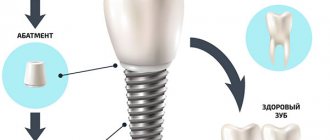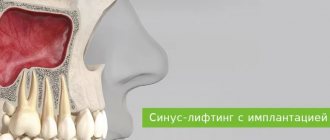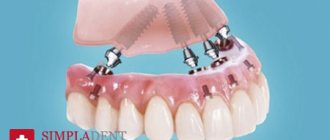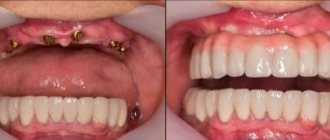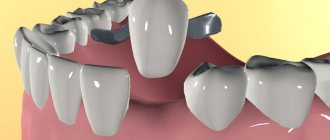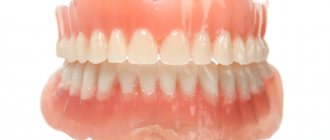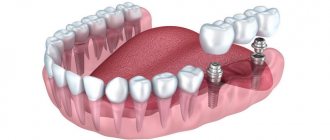Single-stage (instant) implantation is the restoration of teeth when the implant is installed in the hole immediately after the removal of the natural tooth, and therefore this procedure occurs in one visit to the doctor.
It is most often used in places where the aesthetic component is important, that is, in the smile area.
Instant implantation is preferable to two-stage implantation in cases where it is necessary to restore several teeth at the same time.
This technique allows you to shorten the patient’s rehabilitation period, and sometimes immediately install a temporary prosthesis, with which the person can immediately begin chewing.
Restoring a tooth immediately after its removal allows you to avoid the process of building up bone tissue, since there is no loss of it, as a result of which the gums are not cut and are less injured.
Technology of one-stage dental implantation
Dental implantation is the implantation of an artificial titanium root (implant, implant) into the bone tissue of the jaw, onto which an adapter (abutment) is subsequently attached and prosthetics is performed - the installation of an artificial tooth crown. The implantation method for restoring dentition was first used after the discovery by Swedish professor Ingvar Brenemark of the phenomenon of osseointegration - the ability of bone tissue to fuse with the inserted titanium rod. The beginning of the practical implementation of this method of dental implantation occurred in the late 70s - early 80s of the last century. People have the opportunity to regain lost teeth.
Single-stage (immediate, immediate, immediate, express) implantation is a well-known and widespread technique. The operation of intraosseous insertion of a titanium rod (artificial root, implant) and osseointegration (implantation of the root into the jaw bone) is carried out in one stage, perhaps even in one day. After installing the titanium root, the gum is not sutured; the abutment and crown are immediately installed. According to the doctor’s decision, simultaneous implantation is carried out in one stage or two stages.
Implant installation and crown fastening
Each type of dental implantation has its own indications and contraindications, so the choice of technique should be entrusted to the doctor, he will make it after a thorough examination and additional examination of the patient.
Cost of implantation with immediate loading
Since implantation with immediate loading is a one-stage implantation that involves fewer manipulations, it will have a lower cost compared to classical dental implantation. However, the exact price of implantation with immediate loading can only be found out in the clinic and here’s why:
- You need to decide on the implantation technique;
- Select implants;
- Consider the cost of preparatory procedures and temporary prosthesis.
And if you are interested in the price of turnkey implantation, then you need to take into account in the total cost the price of a permanent prosthesis, which can be made from different materials and using different technologies. Therefore, to determine your possible costs for dental implantation, the best thing to do is come to the clinic and ask the implantologist to create an individual treatment plan for you!
Indications for immediate implantation
The operation to restore the dentition immediately after tooth extraction is carried out:
- to restore one tooth that has been destroyed due to caries or trauma, especially when the neighboring teeth are healthy and do not need to be prepared;
- when the tooth root is destroyed;
- when a front tooth is removed for various reasons with the formation of a cosmetic defect, implantation returns the patient the beauty of his smile;
- when it is impossible to restore the normal shape of the tooth through prosthetics.
Pros and cons of the procedure
Instant dental implantation immediately after tooth extraction has its advantages and disadvantages.
Advantages of one-stage dental implantation
Currently, most experts consider simultaneous dental implantation to be the optimal prosthetic method, since it:
- is the most physiological, promotes uniform distribution of load between natural and artificial teeth;
- prevents atrophy (decrease in volume) of the jaw bone tissue and deformation of the dentition;
- allows you to quickly eliminate cosmetic defects;
- more economically profitable;
- no need for frequent visits to the dentist;
- helps quickly eliminate cosmetic defects;
- The appearance of artificial teeth does not differ from adjacent natural ones.
Disadvantages of one-stage dental implantation
The main disadvantage of instant implantation is the impossibility of its use after a traumatic tooth extraction.
Simultaneous implantation is not carried out when there is an exacerbation of the inflammatory process at the site of the tooth being removed
Types of express dental implantation
In recent years, there has been a significant increase in demand for quick methods of dental restoration. Experts also believe that in the absence of contraindications, rapid dental implantation (express implantation method) is the most physiological and justified. In this case, a thorough preliminary examination of the patient to identify indications and contraindications for a particular technique is of great importance.
Classic one-stage dental implantation
The essence of classical one-stage implantation is the installation of a titanium root immediately after tooth extraction (instant implantation). The method allows you to completely preserve all the functions of the lost tooth and prevent bone tissue atrophy.
The operation can be carried out in one stage: the destroyed tooth is carefully removed, a titanium rod is placed in its place, corresponding to the shape, length and volume of the removed root, an adapter (abutment) and a temporary crown are attached on top. To ensure that the load on the artificial root is not too high, the temporary crown is usually shorter than the adjacent teeth. After osseointegration (engraftment of the titanium root) is completed, the temporary crown is replaced with a permanent one.
The technique is used mainly to restore teeth with one root; it is especially often used to restore front teeth. Treatment takes 1 – 2 days. Contraindications are common to all implantations. If the postoperative regimen is followed, complications are minimal.
Simultaneous implantation happens:
- With immediate loading with a temporary crown. A temporary plastic crown is placed along with the implant; after a while it is replaced with a permanent orthopedic structure. This protocol is considered a priority option in case of a favorable clinical picture and when it is necessary to restore a tooth in the frontal zone.
- With immediate placement of a healing abutment. To create an aesthetic gum contour of the required volume and shape, the gum former is fixed to the implant. This method is used if, after extraction, the condition of the gums does not allow the installation of a crown.
- Without immediate loading of the implant (with suturing of the implant). This protocol is used for complex tooth extraction, if there is damage to the soft tissue in the area where the implant is installed, or if there is a serious lack or damage to the bone. The gums are sutured after implantation of the titanium root, and prosthetics with a crown are performed after the wound surface has healed.
Basal implantation
Basal implantation technique
The essence of the method is the installation of a titanium root in the deep basal layers of the jaw bone tissue. The indication for the use of this method is the long-term absence of one or more teeth, as a result of which atrophy of the jaw bone tissue has occurred and it is not possible to install a titanium root in the socket.
A feature of basal dental implantation is its minimal trauma: soft tissues are not cut, the gums are simply moved back and a deep hole is drilled in the jaw bone with a special tool, where the implant is inserted. That's why the method is called seamless. Sometimes a titanium rod is specially inserted obliquely, but the peculiarities of the technology are such that the artificial crown occupies a normal position.
Express dental implantation using the basal method can be used to restore 1–2 or several teeth at once. The latter is even preferable, since the risk of injury to the roots of adjacent teeth by the lateral direction of the titanium root is reduced.
Installation of the implant and temporary crown will take 3-4 days, the permanent crown is installed after the root has healed. The method is gentle, so contraindications to it are minimal, complications are rare.
All-on-4
The essence of the All-on-4 method (all on four) is that 4 implants support the installation of a fixed prosthesis with immediate loading. This method of express dental implantation is relatively new, but every year it is increasingly being introduced into practice, as it allows you to quickly restore the dentition on a completely toothless jaw, that is, complete implantation.
On the first day, 4 titanium roots are installed: 2 vertically in front and obliquely on the sides, which allows the implants to enter the basal layer of the bone and firmly anchor there. After 2–3 days, a fixed prosthesis is installed and the patient begins to feel his own teeth. You can chew, but at first only soft food, gradually increasing the load. If desired, the patient can periodically visit the dental hygienist to clean the denture - it can be easily removed and put on.
The method can be used even with slight atrophy of bone tissue. A contraindication is significant atrophy of the jaw bone. Complications are very rare.
All-on-6
The essence of the All-on-6 method (all on six) is the same as All-on-4. But thanks to the installation of 2 additional lateral implants, this mount is more reliable, it can withstand greater loads, and therefore can be used in cases of significant atrophy of the jaw bones. However, the maximum degree of atrophy is a contraindication for this method of express dental implantation. There are few complications.
Advantages and disadvantages
The main advantage of the technology under consideration is the possibility of almost instant restoration of the aesthetics of the dentition. The color of the temporary prosthesis is matched to the shade of the natural enamel of the adjacent elements, so the crown (“bridge”) fits perfectly into the dentition. The fact that surgery is performed only once when installing an implant is also positive. In addition, the temporary prosthetic structure does not allow the gum in the defect area to recede, thereby worsening the aesthetics of the smile. Another important advantage is the reduction of time spent on implant-supported dentures (compared to the two-stage method). The disadvantages of this method include the presence of many limitations, including the lack of bone tissue in the integration zone.
The network of dental clinics “Smile” offers patients single-stage dental implantation services. Contacting our branches has significant advantages:
- operations are performed by highly qualified surgeons;
- all dental procedures are carried out in accordance with international standards;
- family and cumulative discounts are provided;
- pricing of services depends on the characteristics of the clinical case and the cost of the implantation system;
- We work according to a schedule convenient for patients: every day until 21:00 (on Sunday until 16:00).
You can make an appointment at any of the branches of our clinic in Moscow, located within walking distance from metro stations:
- Alekseevskaya (VDNKh district, etc. Mira), address: st. 3rd Mytishchiskaya house 3, building 2;
- Shelepikha, address: Shelepikhinskaya embankment, address: building 34, building 1.
The use of the latest technologies, extensive practice and equipping the clinic with modern equipment allow us to successfully perform dental implantation using any method, regardless of the complexity of the clinical situation. We guarantee the safety and effectiveness of the services provided. We will restore the attractiveness of your smile!
Types of implants for immediate implantation
The type of implant is selected individually
To successfully carry out a one-step implantation of a titanium root, our doctors choose the most suitable implant. For such an operation it must have the following properties:
- high quality material - either pure titanium is used (Grade 4, impurities no more than 2%), or with a small percentage of vanadium and aluminum impurities (Grade 5, impurities up to 10%); the more impurities, the stronger the material (it must withstand high loads), but the quality of osseointegration decreases; titanium rods do not cause tissue irritation or allergies and have a high survival rate;
- high-quality technological processing of the artificial root - its survival in bone tissue (osseointegration) depends on this;
- one-piece one-piece design - the rod and abutment are a single unit; after installing the implant, the abutment protrudes above the gum and you can immediately install a crown on it; sometimes collapsible structures are used, in such cases the abutment is screwed onto the rod immediately after its installation;
- a certain shape of the rod (pin):
- apical pins are long and thin, their surface is covered with threads, which allows them to be screwed into the jaw bone and firmly fixed in it; has a non-aggressive thread with a constant pitch; such pins are used when the patient’s jaw bone density is high; temporary and permanent crowns are securely attached to them;
- coronal pins - they are wider and shorter, slightly narrowed downwards and covered with threads; this shape allows, when screwing in the pin, to compact the bone and more correctly distribute the load on the jaw bone; used for low jaw bone density.
Manufacturers
Modern dental implants are a carefully calibrated, balanced system. Manufacturers are constantly improving their products, releasing a line with implants of different lengths and volumes. This allows our doctors to choose the most suitable option for each patient.
Comparison table of implants from global manufacturers by survival rate, warranty period and price:
| Manufacturer | % survival rate | Osseointegration rate | Guarantee | Price |
| Astra Tech, Sweden | 99,3% | accelerated | lifelong | 55,000 rub., premium class |
| Dentium, South Korea | 99,2% | regular | lifelong | 20 thousand rubles. Economy class |
| Straumann, Switzerland | 99,4% | accelerated | lifelong | 35 thousand rubles. premium class |
Stages and timing of one-stage implant installation
Simultaneous dental implantation allows you to preserve the natural physiological state of tissues: the volume of bone and mucous membrane. In order for dental restoration to be successful, it is necessary to follow surgical technologies (protocols) developed specifically for this type of intervention.
Preparation
Before undergoing immediate dental implantation, the patient must undergo a thorough examination. To do this, we consult a dental surgeon. He interviews the patient about complaints and existing diseases (nothing can be hidden, since some chronic diseases or taking certain medications can interfere with the implant’s healing), examines the oral cavity and the damaged tooth, and then sends the patient for additional examination:
- laboratory tests - general blood test and blood clotting test (coagulogram);
- instrumental studies : orthopantomography (OPTG) - a survey image of the jaw, allowing to assess the general condition of the dental system;
- computed tomography - allows you to identify the volume and density of bone tissue, as well as the thickness of the mucous membrane in the area of the damaged tooth.
The entire examination is carried out within one day, after which the doctor decides whether single-stage implantation is suitable for the patient, what type of implantation should be used, and draws up a surgical plan.
Anesthesia and tooth root removal
First, local anesthesia is performed. Technique – infiltration carpule anesthesia. The periodontal tissues are impregnated with anesthetic using a special carpule syringe with a medication ampoule placed on the side and a very thin disposable needle. It is painless for the patient and convenient for the doctor.
It is very important to carefully remove the root of a damaged or injured tooth, since immediate implantation can only be carried out if there is an intact bone socket and the absence of an inflammatory process in the area of the apex of the tooth root.
Implant installation
Stages of one-stage simultaneous dental implantation in one visit
This stage also has its own characteristics and depends on the type of implant, pre-selected by the doctor in accordance with the density and volume of the jaw bone. The installation consists of the following actions by the surgeon:
- Gum incision is not required if the socket of an extracted tooth is used for implantation. Our doctor treats it with a simultaneous examination: it is important that the bone septa and mucous membrane are intact.
- Implant installation . It is necessary not only to install the selected implant, but also to make it as stable as possible without damaging the surrounding tissue. If the bone is dense and its volume is sufficient, then the titanium rod is simply screwed into the bone and occupies the entire space of the hole. But if the hole is wide and the bone is not dense enough, then artificial bone tissue is inserted into the hole to stabilize the pin. Sometimes there is a need to increase bone volume using a gentle closed sinus lift operation.
- Attaching the crown . The temporary crown is attached to an abutment protruding above the gum. Its height is slightly lower than that of the crowns of adjacent natural teeth, in order to prevent high load on the titanium pin during the period of its implantation (osseointegration). After installing the temporary crown, no suturing is required. The entire operation takes about an hour. If a closed sinus lift is performed at the same time, then everything will take 2-3 hours.
- Osseointegration - lasts 4-5 months when implanted in the upper jaw (the bone is less dense) and about 2 months in the lower jaw, after which the temporary crown is replaced with a permanent one, made of the material most suitable for the patient (ceramics, metal-ceramics, zirconium).
Recommendations for oral care
After immediate dental implantation, you must follow all doctor’s recommendations.
On the first day after implantation:
- immediately after the operation it is better to be in a semi-vertical position - sitting or reclining, so that the head is higher than the body; You also need to sleep on a high pillow - this prevents the formation of swelling and associated pain;
- to avoid problems with the appearance of postoperative swelling, periodically apply cold to the cheek during the first 2–3 hours, for example, a napkin moistened with cold water; Do not heat the cheek over the surgical site;
- You can drink after 3 hours and only unsweetened, non-hot drinks; exclude coffee and strong tea;
- 5 hours after the operation, you can eat semi-liquid, mushy food that does not contain a lot of salt, without sugar and hot seasonings;
- if there is pain, you can take a painkiller, for example, a Paracetamol 500 mg tablet;
- active rinsing of the mouth with antiseptics is not recommended due to possible mechanical damage to the periodontal tissues; instead, make baths with antiseptics, for example, with a furatsilin solution: take a mouthful of the solution and hold for a minute;
- do not smoke or reduce smoking to a minimum - narrowing of blood vessels occurs, impairing healing and osseointegration.
During the period of osseointegration:
- during the first month you should not take a bath or sauna or visit the pool;
- avoid heavy physical activity and prolonged stress - all this reduces immunity and delays implantation;
- do not smoke or limit smoking, as well as the consumption of alcohol, strong tea and coffee;
- do not eat too hard, spicy, hot or cold foods;
- chew mainly on the healthy side, gradually increasing the load at the operation site;
- Do not forget about the need for good nutrition.
After installing a permanent crown, gradually increase the load on the implant and strictly adhere to the rules of oral hygiene.
Hygiene procedures:
- for the first 3 days after surgery, do oral baths with antiseptics twice a day;
- after 3 days you can brush your teeth with a soft toothbrush twice a day;
- After 2 weeks, you can start using special devices for washing teeth and removing food debris - irrigators.
If there are no complications, you can return to standard oral hygiene procedures 2-3 weeks after surgery.
Stages of treatment
At the first stage, tooth extraction is performed. It is important that the procedure is performed without causing major damage to the surrounding bone, otherwise it will complicate healing. The removal process is necessarily preceded by an x-ray, which is necessary to clarify the number of roots and their location. Implantation will be possible only if the size of the hole is comparable to the dimensions of the prosthesis.
At the second stage, the implant is installed in the socket and, if necessary, additionally fixed with bone material. Next, the abutment is screwed on and a temporary plastic crown is put on.
At the third stage, after 4-6 months, the temporary crown is replaced with a permanent one.
Complications after immediate implantation
Like any surgical procedure, immediate dental implantation can have complications. This:
- Early postoperative complications (in the first 2 - 3 weeks) : unpleasant sensations (discomfort) in the first days after implantation, disappears in 1 - 3 days if the patient follows all the doctor’s instructions;
- pain associated with tissue swelling after surgery; relieved with painkillers and last no more than three days, although in some patients they remain for another one or two days;
- postoperative bleeding – associated with the functioning of the patient’s blood vessels; Normally, it may bleed slightly for three days; if it takes longer or the bleeding is severe, you need to consult your doctor - specialists will quickly provide treatment and cope with the bleeding;
- dehiscence of sutures (if they were applied) - a complication usually associated with the individual characteristics of the patient’s tissues; re-fixation is carried out, it always requires the subsequent administration of anti-inflammatory therapy;
- possible implant rejection - most often this occurs in heavy smokers.
With correct preliminary diagnosis, compliance with all indications and contraindications for implantation, as well as the protocol for its implementation, the occurrence of complications is minimized. Therefore, it is very important to choose the right clinic and qualified doctor.
When to see a doctor
The need to see a doctor arises if:
- pain lasts more than three days, swelling in the cheek area increases;
- high fever appears or a slight increase in body temperature lasts more than three days;
- bleeding at the implantation site has increased - immediately apply ice and consult a doctor.
How to choose a clinic
The success of the procedure largely depends on the qualifications of the doctor and the level of services provided. The Saint-Dent Clinic has extensive experience in installing single-stage implants. By contacting us, you receive the following benefits.
- Modern equipment for research and manipulation.
- High-quality implants from European manufacturers.
- Individual approach to each patient.
- Personal support at all stages of treatment.
- Detailed costing of services.
With us you will receive comprehensive dental care at reasonable prices.
Contraindications to simultaneous implantation
This method is not used if there are the following contraindications:
- local : severe inflammatory processes of the gums (periodontitis), bruxism (unconscious clenching of the jaws), a significant decrease in the volume (atrophy) of the jaw bone tissue, the inability to eliminate the inflammatory process in the root part of the extracted tooth, the patient’s violation of oral hygiene;
- general : bleeding disorders, cancer and endocrine diseases, acute infections and exacerbation of chronic inflammatory processes.
Risk of implant rejection
Such strict and numerous contraindications are prescribed to minimize cases of titanium implant rejection. Statistics say 2-4%, and this is a very small figure. But doctors are trying to completely exclude it.
The risks of implant rejection with a one-step technique may include:
- poor removal and severe trauma to the gums;
- plaque in the oral cavity - not only on the teeth, but also on the mucous membrane around the hole;
- weak fixation of the implant - porous bone tissue or other prerequisites;
- incorrect selection of a temporary crown and excessive load on the implant.
FAQ
1. Is there an alternative to classic one-step implantation? Basal implantation, All-on-4, All-on-6.
2. Are single-stage and basal implantation the same thing? No, these are different methods for quickly restoring dentition, and the indications for their implementation are also different. Single-stage dental implantation is an effective express method that allows you to quickly restore a lost tooth without causing damage to the jaw bone tissue.
Literature:
- Ivanov, A. S. Fundamentals of dental implantology / A. S. Ivanov. – Moscow: SpetsLit, 2011. – 765 p.
- Musheev I.U., Olesova V.N., Framovich O.Z. Practical dental implantology: Guide. - M.: Locus Standi, 2008. - 498 p.
- Jang HW, Kang JK, Lee K, et al. A retrospective study on related factors affecting the survival rate of dental implants. Prosthodont. 2011; 3 (4): 204–215.
- Weiss Ch.M., Weiss A. Principles and practice of Implant Dentistry - St. Louis: Mosby, 2001.
Moscow metro station Zvezdnaya, Danube Avenue, 23
